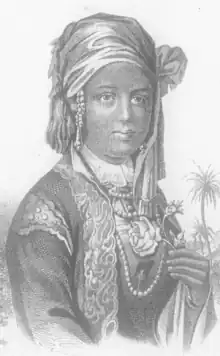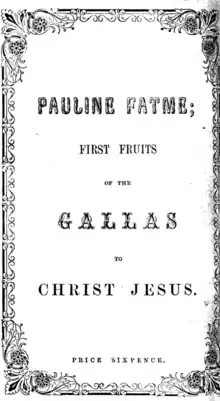Pauline Fatme | |
|---|---|
 Pauline Fathme, in the 1867 frontispiece to Ledderhose's booklet | |
| Born | Ganomeh or Ganamee about 1831 Oromia, Abyssinia |
| Died | 11 September 1855 Switzerland |
| Other names | Pauline Johanne, Pauline Fathme, Ganamee Yaa'ii Sasheedaa |
| Occupation | Protestant missionary |
Pauline Fatme (about 1831 – 11 September 1855), born Ganomeh or Ganamee, was an East African-born Protestant missionary who lived in Württemberg and died in Switzerland.
Early life in Africa

Ganomeh was born in the Oromia region of Ethiopia,[1] then known as Abyssinia, the daughter of Jai Tshasseda Odah, an Oromo (or Galla) leader. She was orphaned when she was a young girl, and trafficked as a slave, first in Sudan, and then in Cairo, under the name "Fatme" (or Fatima).[2][3]
In Europe
By the late 1840s Fatme was a servant in the household of ornithologist and baron Johannes Wilhelm von Müller in Württemberg. She learned to speak German. In 1852, she was baptized as "Pauline Johanne", after the queen of Württemberg. After two years of training at Korntal, the Protestant Missionary Society of Basel supported Fatmé to follow in the mission work of Johann Ludwig Krapf in East Africa.[4] However, she fell ill before embarking on that assignment, and died in 1855, in Switzerland, "in the twenty-fourth year of her age".[5] Her grave is in the churchyard of Riehen, near St. Chrischona. "Her sepulchre is to us a continual admonition not to forget the millions of Gallas", commented an 1857 report.[6]
Legacy
An 1855 German-language booklet by Ledderhose about her life and work was published in English as Pauline Fatme; First Fruits of the Gallas to Christ Jesus (1857).[2] In her memory, her Swiss godfather Christian Friedrich Spittler founded mission stations along the route between Jerusalem and Abyssinia.[7]
References
- ↑ Tafa, Teferi Nigussie (2015). "The representation of 'Ethiopianness' and 'Oromoness' in two Oromo-language novels: "Yoomi Laataa" by Isaayas Hordofaa and "Kuusaa Gadoo" by Gaaddisaa Birruu". Journal of African Cultural Studies. 27 (1): 87. ISSN 1369-6815. JSTOR 24758403.
- 1 2 Ledderhose, Carl Friedrich (1857). Pauline Fatme, First Fruits of the Gallas to Christ Jesus. Translated ... by Dr. Krapf. Revised and edited by J. E. Dalton.
- ↑ Smidt, Wolbert G. C.. "The Role of the Former Oromo Slave Pauline Fathme in the foundation of the Protestant Oromo Mission" in Ethiopia and the Missions: Historical and Anthropological Insights Verena Boll et al., eds. (LIT Verlag Münster 2005): 77-98. ISBN 9783825877927
- ↑ "A Black Female Missionary". Coventry Standard. 1852-12-17. p. 2. Retrieved 2023-10-03 – via Newspapers.com.
- ↑ Gathogo, Julius (2009). "The Birth of Protestant Education in East Africa: Sampling Johannes Ludwig Krapf (1810-1881)" (PDF). Studia Historiae Ecclesiasticae.
- ↑ "Extract from the Eighth Circular to the Friends of the Pilgrim Mission" The Church of England Magazine 42(March 28, 1857): 199.
- ↑ British and Foreign Bible Society (1864). Report of the British and Foreign Bible Society. pp. 218–219.
External links
- Karl Friedrich Ledderhose, Aus dem Leben der Galla Negerin Pauline Johanne Fathme (1867), in German, at Internet Archive